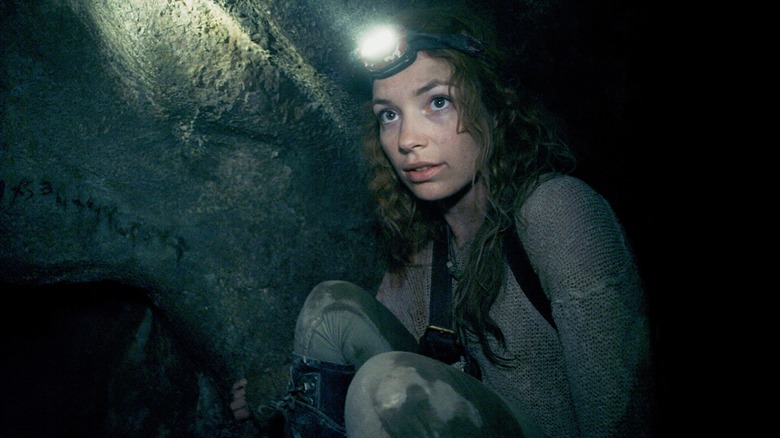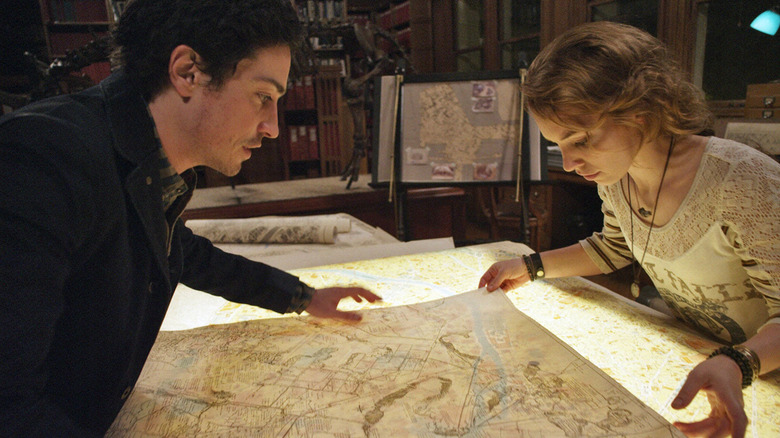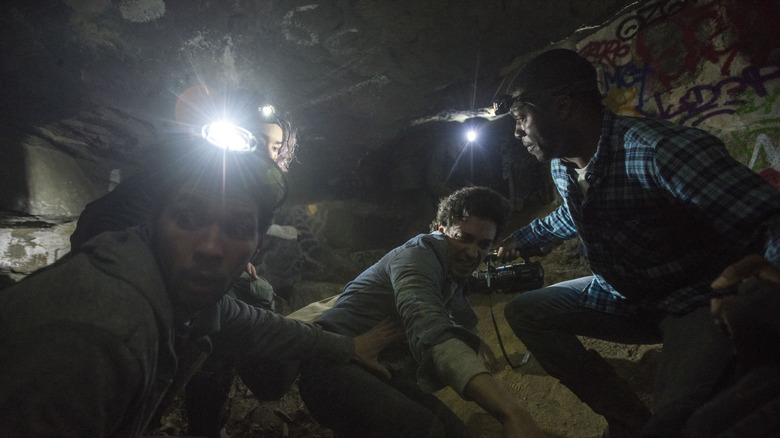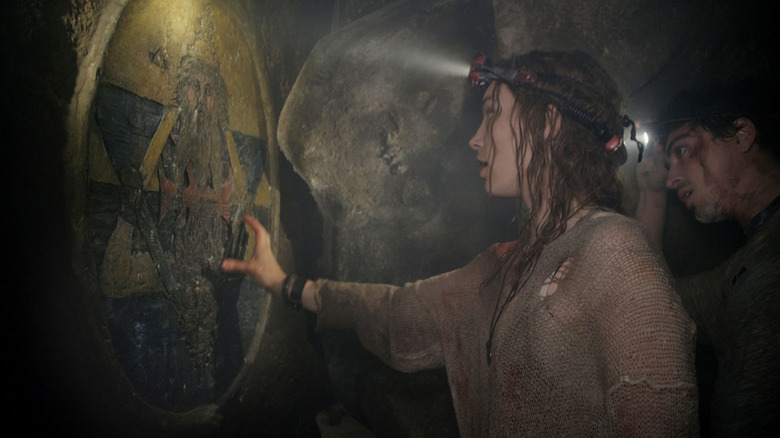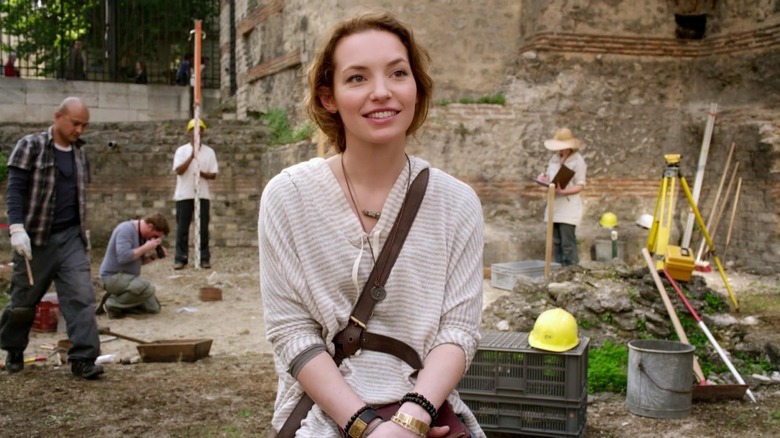As Above, So Below Ending Explained: Raiders Of The Lost Philosopher's Stone
"As Above, So Below" is one of the better found-footage horror films to emerge in the wake of the one-two punch that was "Cloverfield" in 2008 and "Paranormal Activity" in 2009. Where many of its peers struggled to put a fresh spin on the subgenre's tropes, the Dowdle Brothers' 2014 flick is a pulpy Indiana Jones-lite action-adventure that cleverly incorporates mythical elements like the philosopher's stone — or, as we uncultured Yanks call it, the sorcerer's stone — and the Nine Circles of Hell from Dante Alighieri's epic 14th-century poem "Divine Comedy." Admittedly, it doesn't go so far as to reinvent the found-footage wheel, nor does it overcome some of the format's worst tendencies. But it does breathe a little more life into that formula, especially when the action inevitably devolves into people incessantly shaking the camera as they run screaming for their lives.
Of course, the biggest weapon in the film's arsenal is its setting. The story takes place almost entirely in the Paris Catacombs and the labyrinth of caves and tunnels that surround the mass grave, which would be terrifying enough even without the movie's supernatural aspects. "As Above, So Below" was even partly shot in the French capital's real-life catacombs, which only enhances the immersive feeling of its claustrophobic guerilla camerawork. On top of all that, it has a proper ending and doesn't abruptly cut to black in a calculated attempt to emulate the still-shocking conclusion to "The Blair Witch Project." A modern found-footage thriller with legit character arcs and a narrative payoff? They do exist!
What you need to remember about the plot of As Above, So Below
Perdita Weeks stars in "As Above, So Below" as Scarlett Marlowe, an academic who's searching for the legendary alchemist Nicolas Flamel's philosopher's stone, an item that can supposedly grant its user immortality and has preternatural healing qualities. It's also a relic that Scarlett's late father spent his life looking for, prior to his death by suicide. No doubt, dear reader, you have already spotted the parallels between the movie's setup and that of "Indiana Jones and the Last Crusade," specifically in terms of the MacGuffin (like that film's version of the Holy Grail, the philosopher's stone's rejuvenating abilities are the focus here) and the adventuring protagonist going after the same artifact that their father was obsessed with tracking down when they were younger.
The "Indiana Jones" similarities don't stop there. Upon finding a clue during an expedition that nearly costs Scarlett her life (during which she has a brief vision of her father hanging himself), our intrepid-bordering-on-reckless heroine drags her ex-boyfriend George (Ben Feldman) — very much the Marion to her Indy in terms of their dynamic — and her cameraman Benji (Edwin Hodge) to the Parisian Catacombs. Believing that the stone is hidden somewhere in the off-limits section of the catacombs, Scarlett and George put together a motley crew that includes a local guide named Papillon (François Civil), his girlfriend Souxie (Marion Lambert), and their friend Zed (Ali Marhyar) to go treasure hunting. However, as if suffocating passageways and collapsing tunnels weren't bad enough, these amateur tomb raiders gradually come to realize they're traversing the different levels of Hell itself.
What happened at the end of As Above, So Below?
Upon locating the treasure room housing the philosopher's stone (and unable to turn back), Scarlett, George, and the others enter an opening in the ground that leads to a tunnel bearing a Greek inscription that reads "Lasciate ogne speranza, voi ch'intrate," or "Abandon all hope, ye who enter here." This is itself the phrase infamously inscribed on the entrance to Hell in "Divine Comedy," and leads to a horrifying mirror version of the realm of the living (a more literal and nightmarish "Upside Down" than the one in "Stranger Things," you could say). One by one, the members of the group are picked off by the demons, spirits, and other malicious entities that reside therein, until only Zed, Scarlett, and a terminally injured George are left.
When the stone fails to heal George, Scarlett concludes it's a fake and races back to the treasure room to find the real one. Through some quick puzzle work, though, she realizes that she herself now possesses the stone's powers and returns, healing George in the nick of time. With the denizens of Hell in hot pursuit, the trio find another hole they must jump through to escape after confessing their worst sins. This, too, echoes Dante's physical journey through Hell in the "Inferno" section of "Divine Comedy," which is a metaphor for the spiritual journey one must take to find God by admitting and then rejecting their vices. In yet another "Last Crusade" parallel, the three survive this true leap of faith only to land in a cavern with a manhole on the floor — one they must climb down through in order to pull themselves up to the streets of Paris on the opposite side (it's less confusing than it sounds).
To Hell and back
"As Above, So Below" doesn't adhere strictly to Dante's Nine Circles of Hell, using them more as a rough guideline for its own vision of the infernal regions. For example, shortly after entering the restricted area of the catacombs, Scarlett and her crew encounter a group of female cultists (one engaged in what's clearly a not-so-holy ritual) that includes a woman they previously saw at a Parisian nightclub. A little further down, they cross paths with the specter of Papillon's friend La Taupe (Pablo Nicomedes), who vanished in the catacombs weeks earlier and now appears to be stuck there as a ghost. Upon crossing through the gate to Hell, though, the heroes discover the mirror versions of the cultist and La Taupe's ghost are now actively malevolent, suggesting they've entered something akin to the First Circle (the limbo for quasi-blasphemous people who aren't wholly damned).
The film's vision of Hell similarly evokes the imagery of "Divide Comedy," like when Scarlett is forced to wade through a pool of blood that comes alive and tries to pull her under, recalling the Phlegethon (a river of "boiling blood") from the Seventh Circle (which is linked to violence). More generally, "As Above, So Below" carries over the poem's theme of sin by forcing its heroes to confront their greatest regrets in Hell, like when Scarlett ignored her father's phone call right before he died and when George was unable to save his little brother from drowning in a cave when they were kids. But where the pair are ultimately able to voice their mistakes out loud, Papillon is unable to do so upon seeing the ghost of an old friend in a burning car. ("It wasn't my fault!" he pleads before being sucked into the vehicle to his death.)
What the Dowdle Brothers have said about the ending
In its epilogue (a video log featuring Scarlett), "As Above, So Below" suggests it was the selfless nature of Scarlett's quest — to prove her father's quest to find the philosopher's stone wasn't fruitless — that held the key to her salvation (and, quite possibly, her ability to wield the stone's powers). When interviewed by Collider in 2014, John Erick and Drew Dowdle also emphasized the importance of Scarlett's knowledge, as well as the way alchemy ties in with the film's larger theme of, as Drew Dowdle put it, "purification." In his own words:
"We have an alchemical theme going on in the movie too, where Scarlett Marlowe, our lead character, is an urban archaeologist, but she has a real deep understanding of alchemy. Her father is one of the world's preeminent alchemists and the idea of purification, purifying one's soul, is a theme that she's very well versed in and as we get deeper that knowledge comes more and more into play."
During a separate interview with Complex around the same time, Drew Dowdle also recalled pitching the film to Legendary Pictures executives and being relieved when they immediately grasped the nature of the characters' descent into Hell. "We were expecting crickets in the room, but they surprisingly reacted with, 'F**k, yeah! It's like psychotherapy, where you have to go deeper and deeper to unburden yourself,'" he noted. In point of fact, it's only by plumbing the depths of the underworld that Scarlett, specifically, is finally able to voice her greatest trauma out loud and begin the healing process.
"As above, so below. As I believe the world to be, so it is," Scarlett observes at one point. By facing an actual Inferno, she's finally free of her own living Hell.
